
Guests
- Karen Coatesco-author of Eternal Harvest: The Legacy of American Bombs in Laos and senior fellow at the Schuster Institute for Investigative Journalism at Brandeis University.
- Jerry Redfernco-author of Eternal Harvest: The Legacy of American Bombs in Laos and senior fellow at the Schuster Institute for Investigative Journalism at Brandeis University.
As President Obama becomes the first American president to visit Laos, we look at the legacy of the U.S. bombing campaign there during the war on Vietnam. The U.S. dropped at least 2 million tons of bombs on Laos. That’s the equivalent of one planeload every eight minutes, 24 hours a day, for nine years. Experts estimate that Laos is now littered with as many as 80 million bomblets—the baseball-sized bombs found inside cluster bombs. This week, Obama pledged $90 million to help clear Laos of the unexploded U.S. munitions. We feature excerpts from our interview with a Laotian bomb accident survivor and victim assistance advocate, and speak with Karen Coates and Jerry Redfern, co-authors of the book “Eternal Harvest: The Legacy of American Bombs in Laos.”
Transcript
NERMEEN SHAIKH: We begin today’s show with President Obama’s historic trip to Laos, the first trip there by a sitting U.S. president. Obama has so far refused to issue a formal apology for the secret U.S. bombing campaign in Laos during its war on Vietnam. From June 1964 to March 1973, the U.S. dropped at least 2 million tons of bombs on the small, landlocked Southeast Asian country in what would become the largest bombing campaign in history. That’s the equivalent of one planeload every eight minutes, 24 hours a day, for nine years—more than were dropped on Germany and Japan during World War II. Laos authorities say as many as one-third of these bombs did not explode at the time. This week, Obama pledged $90 million to help clear Laos of the unexploded U.S. bombs.
PRESIDENT BARACK OBAMA: For the United dates, one of the wars from our history is the conflict called the Vietnam War. It’s a long and complicated conflict that took the lives of many brave young Americans. But we also know that despite its American name, what we call it, this war was not contained to Vietnam. It included many years of fighting and bombing in Cambodia and here in Laos. But for all those years in the 1960s and '70s, America's intervention here in Laos was a secret to the American people, who were separated by vast distances and a Pacific Ocean, and there was no internet, and information didn’t flow as easily. For the people of Laos, obviously, this war was no secret. Over the course of roughly a decade, the United States dropped more bombs on Laos than Germany and Japan during World War II. Some 270 million cluster bomblets were dropped on this country.
AMY GOODMAN: Experts estimate Laos is littered with as many as 80 million “bombies,” or bomblets—baseball-sized bombs found inside cluster bombs. Well, since the bombing stopped over four decades ago, tens of thousands of people have been injured or killed as a result. In 2013, Democracy Now! spoke to Thoummy Silamphan, a bomb accident survivor and victim assistance advocate. He explained how a bomb exploded when he was an eight-year-old child collecting bamboo shoots.
THOUMMY SILAMPHAN: One day, I needed to find some bamboo shoots for to feed my family, to make soup. So—and when I saw the bamboo shoots, and I tried to dig into bamboo shoots. After that, the bombie explode to me.
AMY GOODMAN: What you call a “bombie,” like a bomblet, exploded?
THOUMMY SILAMPHAN: Yes, because at that time in my village or in those areas, we have a lot of the bombing, and we don’t know the bomb under ground. And when we’re digging for bamboo shoots, and then the UXO explode to me, yeah. And it get—I lost my left hand. And that time, it’s very, very difficult for me to continue my life.
AMY GOODMAN: For more on Laos, we go to Albuquerque, New Mexico, where we’re joined by Karen Coates and Jerry Redfern. They are co-authors of the book Eternal Harvest: The Legacy of American Bombs in Laos. They’re both senior fellows at the Schuster Institute for Investigative Journalism at Brandeis University. Their new piece for Medium.com is titled “Obama’s $90 Million for Bomb Clearance in Laos: It’s Not Enough.”
Karen Coates and Jerry Redfern, welcome to Democracy Now! Welcome back. Jerry, let’s begin with you. Your response to the $90 million that President Obama has pledged to help Laos clear itself of these unexploded bombs?
JERRY REDFERN: First off, I’d like to thank you for having us back on, and good morning to both you, Amy, and Nermeen. The $90 million that Obama pledged, at first, sounds like a lot, but really, when you run the math and do the numbers, you see that it’s actually a fairly nominal increase in the overall spending that America has been spending for the last several years for cleaning up the problem in Laos. And when you put it in context of the amount of UXO, the amount of unexploded ordnance, that remains in the ground and in Laos at this point, it’s really a fairly small amount.
NERMEEN SHAIKH: And could you specify, Jerry, how much, as a percentage, of these bombs have already been cleared?
JERRY REDFERN: Nobody knows. That’s kind of the problem. The numbers that everybody talks about, and that you brought up, they’re accurate as far as we know. That said, we also know that that is the low estimate of it. The 580,000 missions, we know that there were many more. The records that the 580,000 missions came from were incomplete; large parts of the data source originally were destroyed and are missing. And we also know that large numbers of airplanes that were sent to do bombing runs in Vietnam, for example, came back over Laos to bases in Thailand and, on their way back, would randomly drop their loads in Laos. And we have no records whatsoever of those loads that were dropped. So we don’t actually know how much was dropped in the first place. We know it’s more than the numbers that we talk about. So, we can’t say, as a percentage, at all, how much has been cleared to this point. To this point, in terms of land in Laos, roughly 1 percent of what they think, of what many experts believe, to be the contaminated area in Laos has been cleared at this point.
AMY GOODMAN: In 2013, Democracy Now! spoke to Manixia Thor, who leads an all-women bomb clearance team in Laos. She explained what her work entails.
MANIXIA THOR: [translated] So, every day, as an all-female demining team, we go out and we dig and try to find bomblets on land where people live and farm and work. So, she’s just emphasizing the importance of the job and the importance of clearance, because it’s people’s livelihoods and it’s people’s lives. If they don’t work the land, they don’t eat.
AMY GOODMAN: How did you choose to do this? This is an incredibly dangerous job.
MANIXIA THOR: [translated] It’s very dangerous. I’m afraid. Other people are afraid. And so this work is necessary, because there are so many bomblets, and it’s so dangerous for the people in the country. And so it’s necessary work.
AMY GOODMAN: I asked Manixia Thor what message she has for Americans.
MANIXIA THOR: [translated] Yeah, this is an opportunity to tell the American people about what is going on in my country and the problem of UXO. The war might have ended 40 years ago, but for the people of Laos, it really hasn’t. And it’s still very alive for many of us in Lao today. So the hope is that as people hear and understand the problems, that there will be more support, there will be more awareness, and that we will get additional support to do our work.
AMY GOODMAN: That was Manixia Thor. Karen Coates, President Obama announced the $90 million. Do you know how they arrived at this number?
KAREN COATES: I honestly don’t. It’s hard to say.
AMY GOODMAN: While he announced this, he did not quite offer an apology to Laos. Now, again, the amount of bombs that we’re talking about that were dropped on this tiny country, if you can explain? One of the things that we said was the U.S. dropped at least 2 million tons of bombs on Laos, the equivalent of one planeload every eight minutes, 24 hours a day, for nine years—more than were dropped on Germany and Japan during World War II.
JERRY REDFERN: Yes. So, I think what you’re getting at is you’re asking how much will, perhaps, the increase in money be clearing, going forward. And we know that—it’s a bit hard to say, because it takes different amounts of money to clear different types of ordnance when it’s in the ground. We know that last year, roughly, overall, there was $40 million—or, this year is budgeted for roughly $40 million for clearance in Laos, I gather, right? And if you’re to divide up $90 million by three over the three-year period, they’re talking about increasing roughly $30 million a year going forward. When we sort of did a back-of-the-envelope calculation yesterday and the day before on how much extra clearance this can do, Obama is roughly saying—and again, this is just a back-of-the-envelope calculation—maybe another 225,000 pieces of UXO, another 225,000 bombies, to be cleared from Laos. But if you look at the overall guesstimate number of perhaps 80 million-some remaining in the ground in Laos, you can see that that’s just a tiny fraction of what remains in Laos at this point.
NERMEEN SHAIKH: Karen Coates, can you talk about the fact that President Obama did not issue a formal apology for this bombing campaign and its continuing legacy, and whether you expected him to issue a formal apology?
KAREN COATES: I did not expect him to issue a formal apology. I don’t think that that is typical of what American presidents do in a situation like this. I think that the Lao people would have loved to have heard an apology, but I’m not sure that they necessarily expected one, either. But what I do know from talking to many Lao people over the years is that they—they welcome his presence. They welcome the opportunity to create a new relationship with the United States, as President Obama has outlined. And so, I have a lot of questions, going forward, as to what exactly is going to come of his statements about working with the Lao people, the Lao government, to help develop the country, which is exactly what the Lao people—when we’ve talked to survivors of accidents and people who have survived through the bombing campaign, what they say today is that they want to put the war behind them, and they want to grow in the future, and they would love the help of the United States government in doing that.
NERMEEN SHAIKH: And, Karen, one of the less-known impacts of these bombs is on the access to food in the country, because 80 percent of people in Lao rely on their land to grow food. So could you talk about that? What has the impact of that been on people there?
KAREN COATES: Well, the presence of unexploded bombs is—it’s an incredible impediment to food security, because if you have bombs in your field or the possibility of bombs in your field, you’re afraid to go out there and dig. It’s dangerous to dig in most of Laos. And as a farmer, you have to do that every day. So, people are constantly putting their lives at risk. And there are large tracts of the country that could be put to agricultural use, but haven’t been for 40 years because of the presence of bombs.
AMY GOODMAN: I want to go back to Thoummy Silamphan, a bomb survivor and victim assistance advocate in Laos. He spoke about the legacy of the U.S. bombing of his country.
THOUMMY SILAMPHAN: We know, as well, the war is ended and stopped many years ago, but now the UXO continue to kill and injure people until now. And that is why we want to involve for the Legacies of War. I think Legacies of War is very, very important for the Lao people, especially for the UXO clearance and for victim assistance in Laos, because now we have more than hundred town the UXO explode in Laos. And now we also have many survivors that are just waiting for support and help.
AMY GOODMAN: That was Thoummy Silamphan, a bomb survivor and victim assistance advocate in Laos. Jerry, your final comment, as President Obama leaves Laos?
JERRY REDFERN: I’d like to say that there are approximately 15,000 people who are direct victims of UXO accidents still living in Laos to this day, who are physically directly affected by exploding ordnance. But actually, millions of people in Laos still live in fear of UXO in the ground. So just saying that there are only 15,000 is a bit of a misnomer, perhaps. It’s something that Obama brought up. That said, as well, I’d also like to say, not to come off as this being completely bad, it is great that the United States did offer more money to do further clearance, but we just feel that he could do more. He could have offered more.
AMY GOODMAN: Jerry Redfern and Karen Coates, co-authors of Eternal Harvest: The Legacy of American Bombs in Laos, senior fellows at the Schuster Institute for Investigative Journalism at Brandeis University. We’ll link to your piece at Medium.com, “Obama’s $90 Million for Bomb Clearance in Laos: It’s Not Enough.”
This is Democracy Now! When we come back, Lori Wallach on President Obama’s efforts to get the TPP passed through Congress. Stay with us.

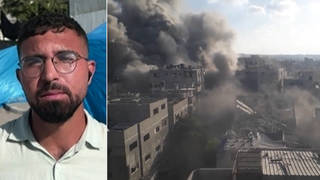
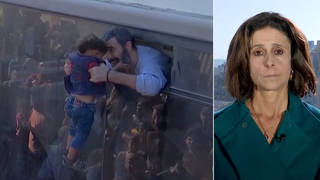
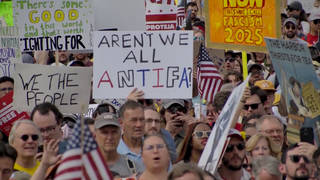
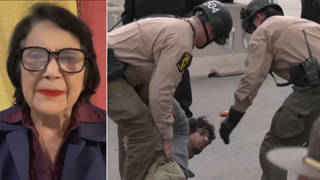





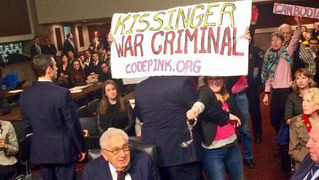

Media Options